Morris & Fan. Reservoir Sedimentation Handbook
Подождите немного. Документ загружается.

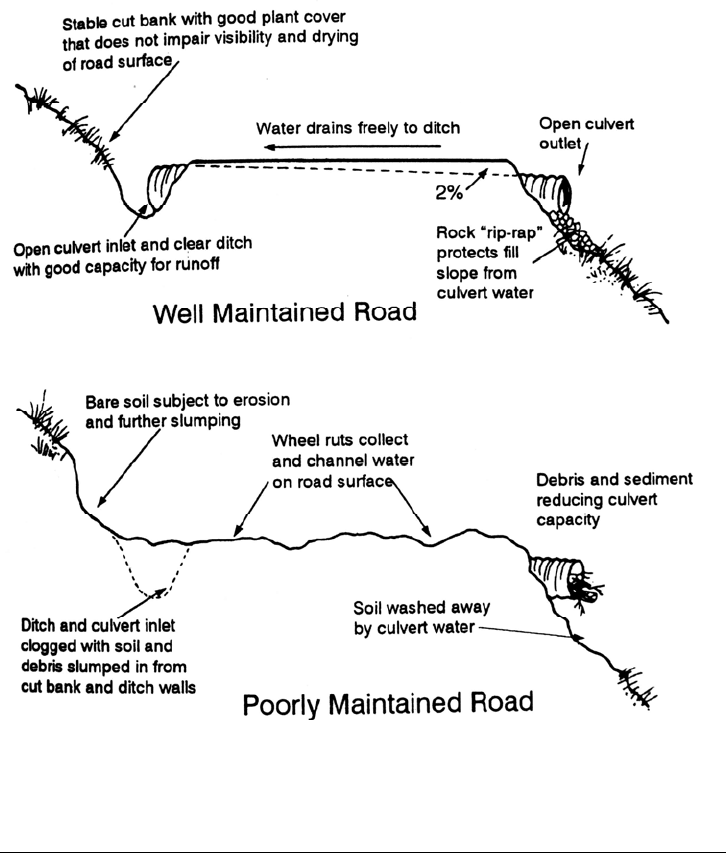
REDUCTION OF SEDIMENT YIELD 12.31
12.9 RESERVOIR SHORELINE EROSION
Reservoirs typically have extremely elongated shorelines compared to natural lakes,
and also more variable water levels. Shoreline erosion can be significant. Shoreline
erosion and slope failures are most prevalent during the first months or years of
impounding, and in rare cases slope failure and the resulting flood wave can endanger
the structure or cause flooding. A geotechnical evaluation is required to identify these
types of problems prior to dam construction.
FIGURE 12.12 Examples of some important differences between well-maintained and poorly
maintained woodland roads (Adams, 1991).
Lyons (1996) surveyed shoreline problems at Bureau of Reclamation Reservoirs.
Erosion was reported at 114 of 154 reservoirs surveyed, and affected 4224 of 15,586 km
(27 percent) of the shoreline in reservoirs for which data were available. Much of the
shoreline damage was reported as "minor." The most common potential impacts of
shoreline erosion were to archaeological sites, government property, water quality, and
fish and wildlife. However, at 14 sites shoreline erosion was considered of sufficient
severity to affect project life.

REDUCTION OF SEDIMENT YIELD 12.32
Shoreline erosion problems in clay, glacial till, and silt at Berlin Lake, Ohio, were
reviewed by Hammel and Sekela (1995). At this site, land acquisition extended only 0.6
m above the flood pool level at the time of dam construction. Private recreational
structures built around the periphery of the reservoir not only encroached too closely to
the banks, but subsurface drainage from septic tanks and waves from power boats further
contributed to natural causes of shoreline erosion such as water level variation and wind
waves.
In some cases it may be feasible to modify the operating plan to reduce water level
fluctuations and resultant erosion. Otherwise, because of the long length of shoreline, it is
not generally feasible to protect against shoreline erosion except in localized areas
where high-value property or structures are threatened. Practices to stabilize shorelines in
specific localities may include the use of riprap, sheet piling, or other conventional
engineering measures, and reduction of boat speeds to minimize wake.
12.10 CONTROL OF CHANNEL EROSION
12.10.1 Types of Channel Erosion
There are several types of channel erosion, and different control strategies are required
for each. One type of channel erosion results from the natural tendency of rivers to
meander. In this case the "problem" is usually related to the encroachment of human
activities onto naturally unstable floodplain areas, and the desire to essentially freeze
the active channel along a set course. As pointed out in Sec. 6.6, a stream channel which
naturally meanders across a floodplain does not exhibit a change in cross-sectional area
(Fig. 6.9) and is not a significant source of downstream sediment load. Rather, flood-
plains are usually depositional environments. River stabilization techniques are not
discussed here, but can be found in Przedwojski et al. (1995) and Petersen (1986).
A second type of channel erosion occurs when natural stream channels incise,
thereby increasing their cross-sectional area and exporting large volumes of sediments
(Fig. 6.10). The causes of stream incision can be complex and poorly understood, and
while incision may be triggered by land use changes within the watershed, it may also
be part of longer-term natural cycles of sediment storage and release.
The third type of channel erosion involves gullying, a widespread and easily
recognized erosion phenomenon that affects primarily ephemeral drainage on all types of
land use (Fig. 12.13). For the purpose of this discussion, gully erosion is differentiated
from natural stream incision in the following manner: stream incision may be partially
or largely a component of a natural process, whereas the principal agent of gullying is
land use degradation or other human activity that increases runoff, concentrates flows, or
lowers the base level of a stream.
12.10.2 Basic Strategy for Gully Control
The gully erosion cycle was outlined in Sec. 6.5. Erosion control measures in gullies
seek to convert the eroding system into a stable condition as quickly and economically as
possible, creating an environment in which self-perpetuating vegetation becomes
established to permanently control erosion. Because gullies are characterized by high
erosion rates due to concentrated channel flows, it may be necessary to alter hydraulic
conditions before vegetation can become established (Heede, 1976).
Gully erosion control may involve the following measures:
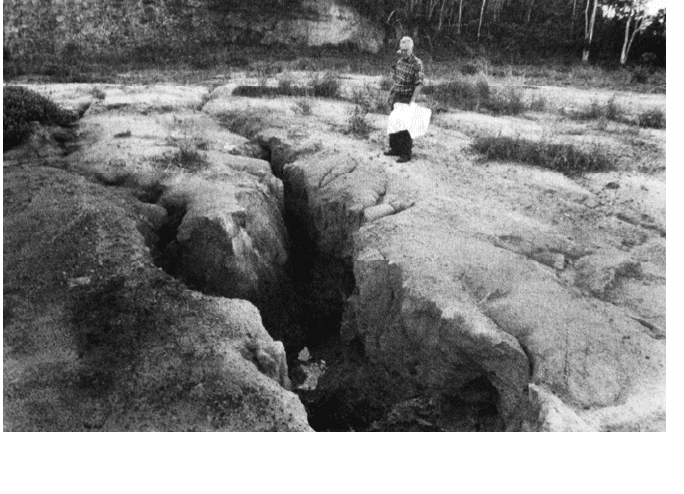
REDUCTION OF SEDIMENT YIELD 12.33
FIGURE 12.13 Gully erosion at a construction site (G. Morris).
1. Di
version of concentrated flows away from the advancing gully headwall
2. Reduction of gully slope by using structural check dams
3. Planting vegetation on the gully floor to retard runoff, trap sediment, and anchor
the soil
4. Sloping vertical gully sidewalls to create stable slopes which are then vegetated
5. Installation of nonerodible channel lining
Permanent control structures such as a series of check dams and structural lining may
be the only option in channels where upstream land use has permanently changed (e.g.,
urban development), greatly increasing peak discharges. The combination of measures
selected will depend on factors such as gully size, slope, climate, and the available
economic resources.
12.10.3 Check Dams
Possibly the first large-scale use of check dams for sediment trapping was by the
Nabatean civilization, which occupied arid lands in present day Israel and Jordan and
established the City of Petra as its capital in 312 B.C. In the 130-km
2
area around Avdat,
115 km south of Jerusalem, the Nabateans constructed 17,000 check dams (130 per
square kilometer), each typically about 2 m high, 40 to 50 m long, and provided with a
spillway. When silted up these dams increased the amount of arable land in the region
fifteenfold (Schnitter, 1994). An interesting and richly illustrated account of runoff
management by Nabateans and Israelites in the Negev Desert, and a modern
reconstruction of their runoff farming system, is provided by Evenari et al. (1971).

REDUCTION OF SEDIMENT YIELD 12.34
Check dams are grade stabilization structures used to reduce the gradient and flow
velocity along a channel. Sediment deposition widens the gully floor and also traps
moisture, assisting the establishment of vegetation and providing more sustained base
flows. The objective of check dam construction is to convert the eroding gully reach into a
depositional zone which will trap bed material, retain moisture, and support vegetation.
There are two serious disadvantages to check dams: they are expensive to build, and
if not maintained they will eventually fail. If vegetation does not propagate and
stabilize the gully prior to check dam failure, the erosion process can be reinitiated and
the check dams may have no long-lasting impact. In practice check dams are often
constructed as a one-time erosion control measure, and maintenance is neglected. They
should be used only when vegetative measures alone cannot be used.
For grade control Heede (1976) recommends the use of numerous small check dams
not more than 0.5 m tall and spaced head-to-toe, the toe of one check dam at the head of
the deposition zone of the next dam downstream (Fig. 12.14a). Spacing as a function of
dam height and stream gradient is shown in Fig. 12.14b. Check dams spaced farther
FIGURE 12.14 (a) Head-to-toe arrangement of check dams along a gully. (b) Distance between
check dams as a function of dam height and gully slope. (redrawn from Heede, 1976.)
apart are
more efficient for sediment trapping because they will be taller and have
greater storage capacity, but smaller structures placed closer together are more effective
for reducing channel gradient. Computational procedures for check dam design are
described by Heede and Mufich (1974).
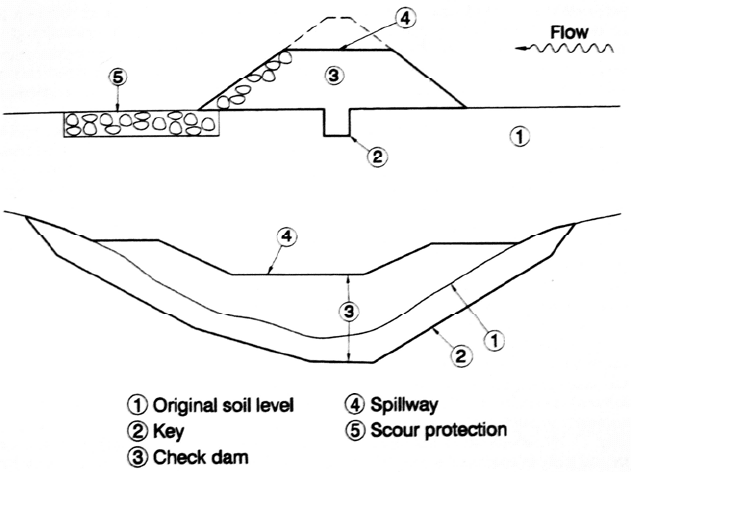
REDUCTION OF SEDIMENT YIELD 12.35
Check dams may be constructed of many different locally available materials: stone,
brush, sandbags, logs, concrete, etc. Selection of the material may depend, in part, on
how rapidly revegetation is expected to occur. The basic components of a stone check
dam are shown in Fig. 12.15, and Heede (1976) provides a detailed description of the
FIGURE 12.15 Basic configuration of a rock check darn (after Heede, 1976).
const
ruction of rock check dams. It is particularly important to provide scour protection
below each dam, to depress the center part of the spillway, and to properly key and
protect the sides to prevent erosion beneath and around the end of the structure.
In areas severely affected by gully erosion, control works within the gullies
themselves can provide a far more effective means of reducing sediment yield than treatment
of slopes. For example, multiple types of erosion yield treatments were installed across 34.4
percent of the 70.1-km
2
Chiuyuan Gully watershed, Shaanxi Province, China (Gong and
Jiang, 1979). Fields on sloping soils were terraced. Abandoned farms, steep slopes, and some
gullies were afforested with trees and shrubs useful for fuel, fodder, and green manure. Grasses
were planted on abandoned land and incorporated into crop rotations. Check dams were built at
317 sites, and some flood waters were diverted to irrigation use. Over a 17-year period these
measures reduced sediment yield by 55 percent. Of this, 46 percent was attributed to the
check dams alone, which trapped sediment and reduced channel erosion by reducing the
slope of the gully floor. The remaining 9 percent reduction in sediment yield was
attributed to the control measures installed on the slopes above the gullies. Of these,
terracing was the most effective measure.
12.10.4 Vegetative Control of Gullying
Under favorable conditions vegetation alone can be used to control gullying. Desirable
vegetation will be stiff enough to provide significant hydraulic resistance, thereby

REDUCTION OF SEDIMENT YIELD 12.36
retarding flow velocity and encouraging sediment deposition. The selection of vegetation
should be matched to the climatic and gully characteristics.
Vetiver grass has been successfully used to control gullying (Grimshaw and Helfer,
1995). Among the many advantages of vetiver are its deep roots (in excess of 3 m), rapid
stabilization, ease of propagation, and the ability to plant it in stiff, compact hedges oriented
perpendicular to the channel where it will retard channel flow and encourage sediment to
accumulate. Unlike "dead" check dams which deteriorate with time, the protection
provided by living vegetation will improve with time as the plants grow and strengthen,
provided that channel flows do not wash away the plants. Vegetative controls are
particularly susceptible to damage by large flow during the establishment stage; repeated
replantings may be required in critical areas and should be anticipated in project budgets.
Heede (1976) cautioned against the use of trees in smaller gullies, since they might create
so much hydraulic resistance that flow would be diverted out of the gully and erode adjacent areas.
However, in larger gullies trees can be highly effective. The loess soils in the watershed of
China's Yellow River include some of the world's most spectacularly gullied landscapes,
with gullies having vertical walls many tens of meters tall. Reforestation of gully floors has
been demonstrated to be an effective gully erosion control measure in this area by Li (1993).
The study area consisted of undulating hills dissected by deep gullies. The mean annual
sediment concentration in runoff from ridges, slopes, and farmland ranged from 20 to 90
g/L. In contrast, the sediment concentration in gully channels averaged 500 to 700 g/L
and typically occurred as hyperconcentrated flow. The effectiveness of gully afforestation
is illustrated by data from trials involving two similar gullies, an untreated 1.15-km
2
control
watershed, and a 0.87-km
2
watershed which was reforested starting in 1954 using four
different tree species. Reforestation was undertaken on the gully floor, which had more
moisture than the ridgeland but was unsuitable for crops because of flooding. Tree
planting was initiated in smaller lateral gullies away from the main eroding flood channels,
and was subsequently expanded downstream into the main channels. As seen in the double
mass plot (Fig. 12.16), afforestation dramatically decreased both water and sediment yield
from the treated gully as compared to the control: between 1958 and 1965, sediment yield
from the afforested gully was reduced 92 percent compared to the untreated gully. The
economic welfare of the region was also improved by the availability of forest products.
Several mechanisms were responsible for reduced sediment yield. Roots helped stabilize
and anchor the soil, and the hydraulic resistance of the stems reduced flow velocities,
resulting in the net deposition of approximately 0.5 m of soil in the afforested gully. In
contrast, channels incised at a rate of 5 m in 30 years in untreated gullies. Increased
infiltration also reduced runoff and subsequent channel erosion.
12.10.5 Channel Linings
Lining materials such as grass, stone, geosynthetically reinforced turf, and concrete can
be used to prevent channel erosion and gullying. Considerable recent attention has been
given to geosynthetically reinforced turf (available from several manufacturers), which
provides more rapid and higher erosion resistance than grass alone and can be substituted
for stone or concrete in appropriate situations (Williams et al., 1996). Because of high
cost, linings are primarily used in urban areas or along transportation corridors.
12.11 EROSION CONTROL STRATEGIES FOR RANGELAND
Pasture is land that could be suitable for growing crops or trees, but which is managed for
forage production and grazing. Rangeland is land which is used for cattle grazing or wild-
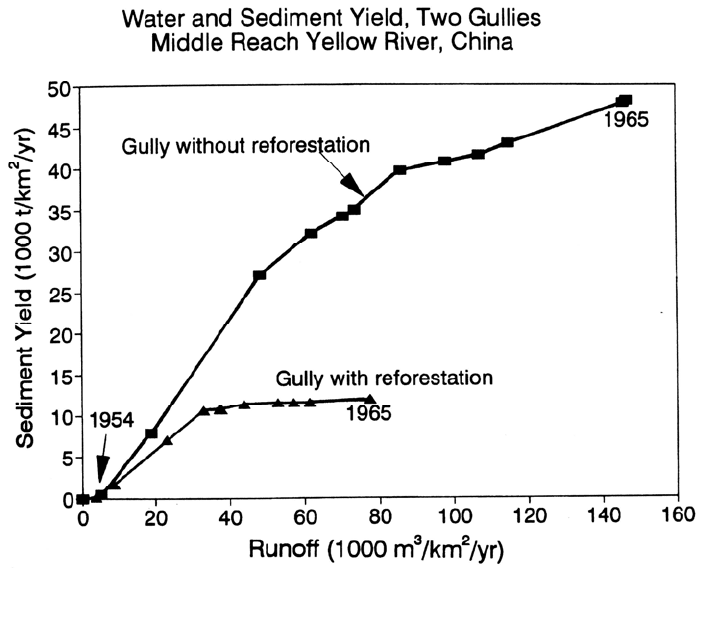
REDUCTION OF SEDIMENT YIELD 12.37
FIGURE 12.16 Cumulative yield of water and sediment from two gullies in China,
illustrating the effectiveness of gully reforestation (drawn using data from Li, 1993).
life habitat rather than cultivated, usually because it is too dry or too steep, or has some
other limitation making it unsuitable for crop production. These limitations, and especially
limited vegetation, tend to make rangelands particularly susceptible to erosion. The
economic productivity of rangelands depends on maintaining a natural and productive
vegetation cover. Because of the low economic unit value of rangeland, the options for
erosion control treatment are normally very limited.
Grazing management tends to focus on: (1) limiting livestock stocking rates; (2)
proper scheduling of grazing, including periods of rest and recovery; (3) livestock
distribution and exclusion from sensitive areas such as riparian corridors by fencing;
and (4) allocation of forage between livestock and wildlife. The mechanical action of
cattle can be particularly destructive to the riparian zone, especially since animals tend to
congregate in this zone for water, forage, and shade. For both pasture and rangelands,
areas of livestock watering, salting, and shade should be located well away from
riparian areas. Fencing of riparian areas is an effective, although costly, method of
controlling livestock access. For example, in a 13-year study of an unimproved pasture
watershed in Ohio, Owens et al. (1996) found that the annual average flow-weighted
sediment concentration was reduced by 57 percent, and total sediment yield by 40
percent, after the riparian area was fenced, even though the herd size was the same as
during the unfenced period, and storm flow was 30 percent greater during the fenced
period. An example of the impact of livestock in a riparian zone is described in Chap.
22.

REDUCTION OF SEDIMENT YIELD 12.38
12.12 EROSION CONTROL STRATEGIES IN URBANIZING
AREAS
Sediment yields are typically low from fully developed urban areas where land surfaces
are covered by vegetation and pavement. In contrast, the sediment yields from
construction sites can be very high. The total sediment yield from an urbanizing area
represents the sediment from the surrounding rural or agricultural land that is not yet
developed, construction sites, and fully developed urban sites. The generalized change
in sediment yield from an urbanizing area as a function of land use and time was
schematically illustrated in Fig. 7.9. Although the total amount of sediment from an
urban area will normally be low once fully developed, the runoff may continue to have
pollutants which can compromise water quality in downstream water bodies. The
increased peak discharge from an urbanized area will also increase channel erosion
downstream.
Erosion control and related water quality requirements in urban environments and
construction sites are normally established by regulation, and both local and federal
ordinances may apply. Because of the regulated nature of this activity, region-specific
best management practices and design standards will often apply. Urban BMPs for
stormwater quality control have been reviewed by Goldman et al. (1986), Schueler
(1987), and Urbonas and Stahre (1993).
The 10 general strategies outlined in Sec. 12.2 are all applicable to construction sites.
Of particular importance are (1) work scheduling to minimize the surface area and
duration that bare soil is exposed to rainfall at any point in time, (2) protection of exposed
surfaces with mulch, vegetation, or pavement as rapidly as possible following earth
movement, (3) use of lined channels and on-site storm drains to reduce channel erosion,
and (4) detention and sediment trapping of site runoff prior to discharge.
Several techniques have been used to trap or otherwise prevent the discharge of
pollutants with stormwater runoff from urban areas. The only feasible strategy for
drainage areas of any significant size (exceeding about 1 ha) is stormwater detention with
plain sedimentation of solids, aided by biological processes when the stormwater pond
includes wetlands. The effectiveness and longevity of different urban stormwater
management practices were reviewed by Schueler et al. (1992). Use of wet ponds and
wetland detention ponds were found to be an effective and long-lived sediment removal
technique. However, the pollutant removal efficiency of normally dry detention ponds
was not always reliable. Methods other than detention can be used to treat small-area
flows, such as that from an individual parking area. Schueler et al. (1992) found that
surface filtration by sand beds can work well, provided that the sand can be raked,
removed, and replaced as required to maintain infiltration capacity. In contrast, many
systems in which the filtration medium is not removed failed because of clogging
problems after several years. These included infiltration basins, deep filtration systems
such as gravel-filled trenches, and porous pavements. Paving systems designed as turf
reinforcement systems were not studied. Grassed swales can prevent erosion, but have
very low pollutant removal efficiencies when there is appreciable flow velocity.
Vegetated filter strips have worked well in agricultural applications, but were generally
found to perform poorly in urban environments because of problems such as excessive
slope (greater than 15 percent), inadequate strip width, uneven terrain which caused flow
channelization, and poor vegetative cover.
One pervasive problem at construction sites is the need to protect bare slopes. The use
of mulches and geotextiles for erosion control on slopes has been reviewed by Rickson
(1995). Contour plantings of vetiver grass (see Sec. 12.4.7) have been found to be an
effective means to vegetatively stabilize road cuts and fills in moist tropical and
subtropical areas. The silt fence is a widely used (and misused) control techniques

REDUCTION OF SEDIMENT YIELD 12.39
designed to retard the flow velocity of sheet runoff, thereby causing sediment
deposition. It is effective only in the control of sheet flow; once flow becomes
concentrated a silt fence is useless. Because flows tend to rapidly become channelized on
construction sites, detention basins are usually recommended, in combination with
upstream erosion control measures, to reduce the amount of sediment that leaves the site.
Techniques for the design of detention basins are given in the next section of this
chapter, and are applicable to treating runoff from construction sites as well as developed
urban areas. When a basin which provides detention and sediment trapping during the
construction phase will also be used after the project is completed, the trapping efficiency
may be expected to change because of the change in the grain size of the suspended
solids load between the construction and post-construction period.
12.13 SEDIMENT DETENTION BASINS
This section outlines design strategies for sediment detention basins. More detailed
discussions are presented by Haan et al. (1994), Urbonas and Stahre (1993), and U.S.
EPA (1986).
12.13.1 Design Philosophy
Basic design strategies for maximizing sediment retention are the opposite of those
outlined in other parts of this handbook, and oriented to minimizing sediment deposition
within impoundments. The most important differences are summarized in Table 12.4.
Because sediment traps will eventually become filled, periodic sediment removal is just
as important as proper design to maintain long-term trapping efficiency.
Sediment yield from impervious urban surfaces is distinctly different from soil. The
erosion rate from soil is related to rainfall intensity and runoff rate. Sediment
concentration tends to increase as a function of rainfall intensity, and exceptional loads may
be produced by large storms which initiate gullying and slope failures. However, on
impervious surfaces the sediment and other particulate matter that collect on the surface
are washed into the stormwater drainage system by the initial part of the runoff, the so-
called first flush effect. Thus, most of the sediment may be washed from the streets and
other impervious areas by the initial runoff, and subsequent rainfall will generate
relatively small amounts of sediment, regardless of the storm intensity.
First flush effects are obvious to even a casual observer in the visual change in runoff
quality from a small impervious drainage area over the course of a prolonged or multiple-
event storm. However, Urbonas and Stahre (1993) have noted that they appear not to
TABLE 12.4 Major Differences between Sediment-Trapping and Sediment-Excluding
Impoundments
Design parameter
Sediment-trapping
impoundments
Sediment-excluding
impoundments
Hydraulic short-circuiting Minimize Maximize
Outlet structures High level Low level
Detention time Maximize Minimize
Portion of hydrograph to trap First Last
Water level during flood High Low
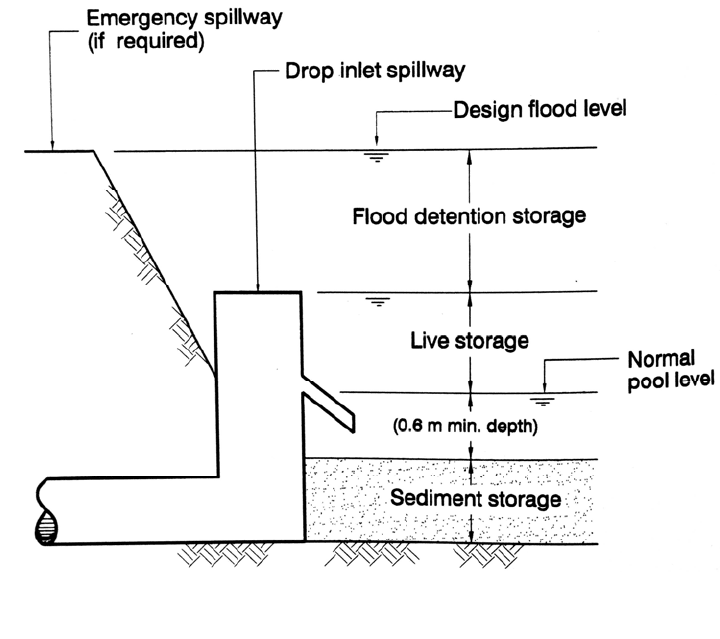
REDUCTION OF SEDIMENT YIELD 12.40
occur in some urban areas. First flush effects may not be apparent in a smaller storm of
insufficient volume or intensity to wash most of the surface pollutants into and through
the storm drainage system, when the point of measurement includes runoff from widely
dispersed areas with large differences in the time required for runoff to reach the
measurement site, and when first flush effects from paved areas are masked by runoff
from construction sites or undeveloped areas tributary to the monitoring site. Because
of variations in storm intensity and travel times, first flush effects should be more
pronounced from a small urban drainage area (such as a single parking area or facility)
compared to the aggregate drainage from a larger urban area.
To maximize the retention of sediment and the pollutants associated with fine
sediment, detention basins should trap and hold runoff from smaller events for a prolonged
period, and provide adequate detention for larger events. A schematic diagram of the
storage compartments in a wet sediment detention basin are presented in Fig. 12.17.
Operation of the basin is described with respect to the outlets and storage areas shown in
the figure.
1. Small runoff events. A small runoff event is one which does not exceed the live
storage volume. These events would normally be described in terms of a runoff depth
(e.g., 1 or 2 cm across the tributary area). The total volume of small runoff events should
be detained in the live storage zone for the longest time possible to maximize the trapping
of fine sediment. However, it should also be drained from the live storage zone fast
FIGURE 12.17 Allocation of storage in a wet detention pond. A wet pond could contain
open water or wetland species, depending on the normal water depth.
